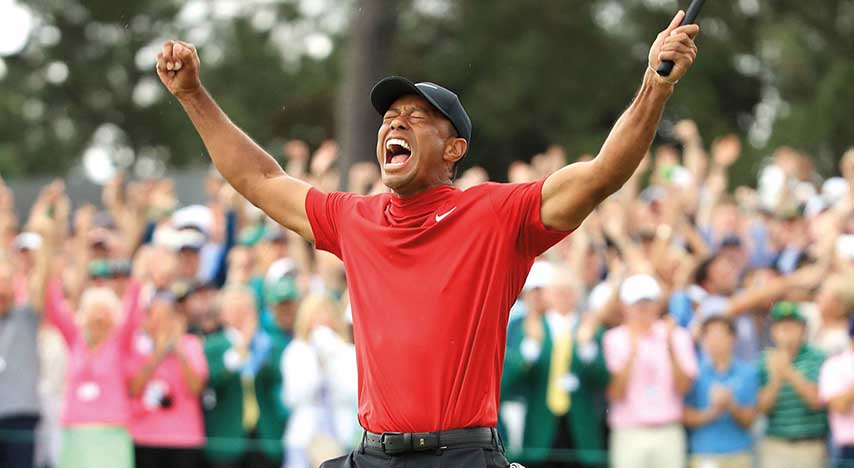How far can the best player of the last three decades go now that, with his triumph at the US Masters, he has shown that - free from physical limitations - he has control over his extraordinary talent? His 15th major, coming 11 years after his previous major (2008 US Open), has shown that, at 43 years of age, Tiger Woods can still battle it out with the best.
In December 2017 he was 1,199th in the world ranking, nine months later he had risen to 13th - after his triumph in the Tour Championship, sixth place in the British Open and second in the US PGA - and at the end of April he was sixth.
Tiger’s progress is surprising, especially after the Jupiter Island (Florida) resident underwent surgery four times for a back injury and he could barely walk just over a year ago.

Far away now are the times, 27 years ago, when a very young Tiger leaped to the forefront of the golf juggernaut with his debut on the US PGA Tour. It was on 2 February 1992 when a thin lad just 16 years old appeared at the Nissan Open in Los Angeles and carded a first round 72, on the world’s premier professional circuit. Then an amateur, Tiger became the youngest player to compete in a PGA Tour tournament. The second day he carded a 75, too many to make the cut at the Riviera Country Club, in a tournament won by Davis Love III.
The Tiger of that era, a slender teenager who weighed 63 kilograms, about 20 fewer than at present, had to ask permission to the head commissioner of the tournament to be able to make his first appearance.
"It was a moment that changed my life," he recalled 25 years later at a time not exactly sweet in his career, which now includes 81 titles on the PGA Tour, including 15 majors, the second highest total after Jack Nicklaus, who accumulated 18. If his second places in PGA Tour tournaments were transmuted into victories, Tiger would have already surpassed 100, since he has been runner-up 31 times. In addition he has won 20 times on other tours.
"It was a great learning curve for me," acknowledged the former world number one. "I realised that I wasn’t very good, that I had a long way to go. At that level, I was not competitive. I was at junior level, not a professional one, and the others were much better than me.”
That unforgettable experience, supervised at all times by his father, Earl Woods, was the prelude to what would lead the young Tiger into the annals of history as one of the greatest golfers of all time.
Knight on the Wall
Who would have thought to tell the lad that one day he would be as famous as the character who looked down at him from a large poster stuck on the wall of his room. The lad was Tiger Woods and the knight on the wall, Jack Nicklaus.
Little Eldrick, Woods’ real name, had a view every night of the history of his idol’s triumphs and he dreamed of emulating them one day. The master’s 18 majors became, over time, an obsession for the Californian. "It has always been my goal to overcome Jack," Woods has acknowledged several times. And it seemed that the goal was within his reach... until in autumn 2009 his life - with the revelation of his marriage infidelities - and his game underwent a radical change.
It is not easy to establish a more or less fair comparison, in the sporting realm, between Nicklaus and Woods, since they are three and a half decades apart in their key chronology, and in that time golf has changed a lot in some aspects, including equipment (clubs and balls) and physical and even mental preparation. However, the essence of competition - a player’s talent - remains valid. In favour of Nicklaus, it should be noted that in his time he had to beat other all-time greats such as Gary Player, Arnold Palmer and Tom Watson (the former won nine majors, and the other two eight each).
Analysing the records of both stars, we can note that at the age of 36 Tiger (now 43) had won 14 majors and Nicklaus had won 14 of his 18, the first one when he was 22 years old (Tiger had six majors at that age: two at 20 and four at 21). The remaining four would be added by the Golden Bear in a period of one decade, when he was 38, 40 (he won two) and 46 years old. In total, Nicklaus won his 18 majors over the course of 25 years, while Woods accumulated 14 wins in a period of 12 years and his 15th title 11 years later.
Before turning professional, Tiger won three US Amateur titles (consecutively), and also won the NCAA Championship and was crowned number one in three editions of the US Junior Amateur.
The number of victories in majors for both Tiger and Nicklaus could have increased notably if they had enjoyed a bit more luck in the last round. Nicklaus finished second in no fewer than 19 majors, while Tiger has been runner-up on six occasions. The Golden Bear succumbed, for example, to Arnold Palmer twice, to Lee Trevino four times and to Tom Watson in four majors. Neither could he resist the onslaught of Seve Ballesteros, who won by three shots in the 1979 British Open. The names of Tiger's rivals, to be honest (Cabrera, Beem, Yang…), are not in the same legendary category.
With his physical ailments overcome (four back surgeries in recent years), his strength restored and his huge talent intact, it was only a matter of time before we saw a return of the Tiger of his triumphant best times.
With his victory last year after a five-year winless drought and his recent good results, and now the Masters icing on the cake, the question is, how long will it take him to once again rise to number one in the world? And will be able to equal, if not overcome, Jack Nicklaus’s majors record? With 15 behind him, Tiger has three more to catch up with the Golden Bear. Mission Impossible? He could follow the example of his idol Nicklaus, the only player who has won five majors after turning 35, the last when he was 46.




